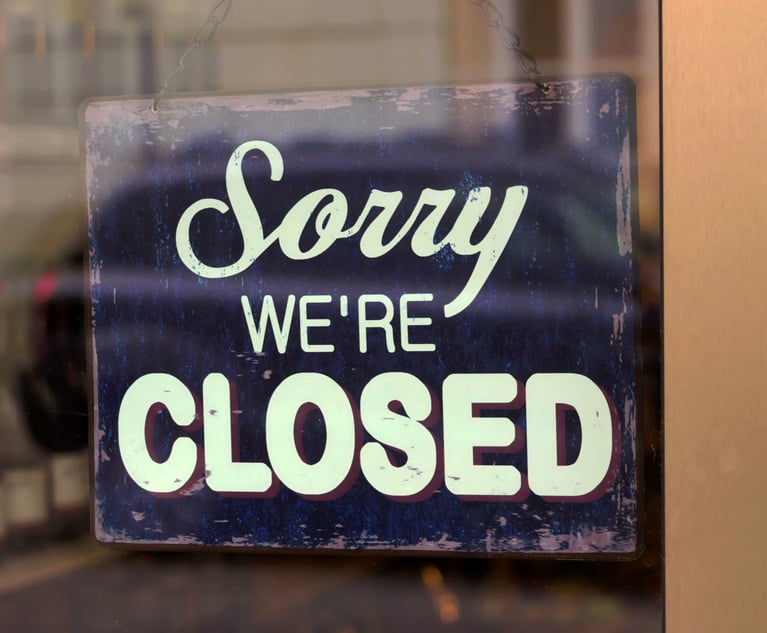Yes, Virginia, There Is a Way to Reduce the Pain of Privilege Logs
Altering the default document-by-document privilege log is probably the best way to reduce the pain of privilege logs.
May 28, 2019 at 10:46 AM
5 minute read
 Todd Heffner of Smith Currie (Courtesy photo)
Todd Heffner of Smith Currie (Courtesy photo)
Privilege logs are awful(ly expensive and time consuming). Is there a way to make them painless? No. Is there a way to make them less awful? Yes. Lots, in fact. There are two general ways to accomplish this, which we'll explore below:
- Reducing what must be included on the privilege log by agreement; and
- Some tips and advice for getting them right in the first place.
First, why privilege logs. For those of you who may have forgotten—or tried to block it out of your memory—Federal Rule of Civil Procedure 26(b)(5)(A) requires the party withholding privileged (or otherwise protected) information to “describe the nature of the [withheld] documents … and do so in a manner that, without revealing [privileged] information … will enable other parties to assess the claim.” Over time, courts have generally interpreted this rule to require a document-by-document log that includes a brief description of why the document is protected, the senders or receivers of the document, and the document's date. Because the rule does not explicitly require this approach, there is some room for alternative arrangements.
Altering the default document-by-document privilege log is probably the best way to reduce the pain of privilege logs. In fact, FRCP 26(f)(3)(D) encourages the parties to discuss privilege in their pretrial conference and FRCP 16(a)(3)(B)(iv) suggests that any agreements the parties reach can be included in the court's scheduling order. Beware, however, that certain jurisdictions limit how far afield you can go from the traditional document-by-document log, so it will be important to research this issue first. There are three main modifications you could make through agreement with opposing counsel:
- No privilege logs;
- Categorical privilege logs (grouping the reason for protection into categories); or
- Metadata-only privilege logs (skipping the reason the document is protected).
You could also agree that certain categories of communications never even require logging, like anything after the date the lawsuit was started, or any emails to or from outside counsel. All of these options come with some potential drawbacks and are unlikely to eliminate privilege challenges completely, but are still worthy of careful consideration.
A good privilege log starts with good privilege determinations on the documents themselves. But making correct privilege determinations is an increasingly difficult task—the roles of lawyers within organizations continue to morph, there are more potentially privileged communications, and there are more potentially confusing agent relationships than ever before. And this task often rolls downhill to the youngest associate on the case. This young associate hopefully learned a bit about privilege in law school, but probably never appreciated how complex the question becomes in practice.
Training reviewers so that they make correct privilege calls, therefore, is the first step to an accurate and defensible privilege log. A great case to read is SodexoMAGIC, LLC v. Drexel Univ., 291 F. Supp. 3d 681 (E.D. Pa. 2018). In it, district court Judge Michael Baylson lays out 13 scenarios involving in-house attorney communications to help the parties understand when claiming privilege is proper. Consider also In re Kellogg Brown & Root, Inc., 756 F.3d 754 (D.C. Cir. 2014) in which then-circuit court Judge Brett Kavanaugh articulates the D.C. Circuit's standard for determining whether an email constitutes business advice or legal advice. (The point here is it won't be the same in every circuit!)
These cases just skim the surface—what about work-product? Do the common interest, self-critical analysis, Upjohn, or Kovel privileges have any bearing on your review? Simply put, privilege determinations are not easy. If you don't take the time to train the reviewers, when it comes time to assemble the privilege log, which requires articulating a reason for why the document is protected, it will be a disaster.
Beyond training, it is helpful if the reviewers have either a direct line of communication with both the client to provide insight into various people's roles, and to someone more senior who can help with the tough calls.
Technology, in the form of email threading or near-duplicate analysis, can also be extremely helpful. For those unfamiliar, both tools help group together similar emails, which will enable the reviewers to make more consistent privilege calls—thus avoiding the embarrassing situation in which you produce a duplicate copy of an email you also happen to have on your privilege log.
Another step you can take is to train your client on privilege. Three basic things you can do are:
- Help them understand what they should label as privileged;
- Encourage them to limit circulation when they can; and
- Get them to explicitly state that legal advice is being requested or that something is being done at the request of counsel.
Finally, it's unlikely that you'll ever handle privilege perfectly, so remember how important (and easy) it is to have a 502(d) order in place.
If you want to read more about reducing the pain of privilege logs, consider The Facciola-Redgrave Framework (https://www.fclr.org/fclr/articles/html/2009/facciolaredgrave.pdf). If you want to stay up to date on interesting privilege decisions—and who doesn't!—you should read Todd Presnell's fantastic blog: Presnell on Privileges (https://presnellonprivileges.com/)
Todd Heffner is a construction litigator and eDiscovery specialist with Smith Currie. Contact him at [email protected].
This content has been archived. It is available through our partners, LexisNexis® and Bloomberg Law.
To view this content, please continue to their sites.
Not a Lexis Subscriber?
Subscribe Now
Not a Bloomberg Law Subscriber?
Subscribe Now
NOT FOR REPRINT
© 2025 ALM Global, LLC, All Rights Reserved. Request academic re-use from www.copyright.com. All other uses, submit a request to [email protected]. For more information visit Asset & Logo Licensing.
You Might Like
View All
A Plan Is Brewing to Limit Big-Dollar Suits in Georgia—and Lawyers Have Mixed Feelings
10 minute read

Trending Stories
- 1Understanding the HEMS Standard in Trusts
- 2Mergers Are About People, Not Paperwork: Here’s Why
- 3Wachtell Partner Leaves to Chair Latham's Liability Management Practice
- 4Morris Nichols Partners to Be Involved With PLI Program
- 5How I Made Practice Group Chair: 'Cultivating a Culture of Mutual Trust Is Essential,' Says Gina Piazza of Tarter Krinsky & Drogin
Who Got The Work
J. Brugh Lower of Gibbons has entered an appearance for industrial equipment supplier Devco Corporation in a pending trademark infringement lawsuit. The suit, accusing the defendant of selling knock-off Graco products, was filed Dec. 18 in New Jersey District Court by Rivkin Radler on behalf of Graco Inc. and Graco Minnesota. The case, assigned to U.S. District Judge Zahid N. Quraishi, is 3:24-cv-11294, Graco Inc. et al v. Devco Corporation.
Who Got The Work
Rebecca Maller-Stein and Kent A. Yalowitz of Arnold & Porter Kaye Scholer have entered their appearances for Hanaco Venture Capital and its executives, Lior Prosor and David Frankel, in a pending securities lawsuit. The action, filed on Dec. 24 in New York Southern District Court by Zell, Aron & Co. on behalf of Goldeneye Advisors, accuses the defendants of negligently and fraudulently managing the plaintiff's $1 million investment. The case, assigned to U.S. District Judge Vernon S. Broderick, is 1:24-cv-09918, Goldeneye Advisors, LLC v. Hanaco Venture Capital, Ltd. et al.
Who Got The Work
Attorneys from A&O Shearman has stepped in as defense counsel for Toronto-Dominion Bank and other defendants in a pending securities class action. The suit, filed Dec. 11 in New York Southern District Court by Bleichmar Fonti & Auld, accuses the defendants of concealing the bank's 'pervasive' deficiencies in regards to its compliance with the Bank Secrecy Act and the quality of its anti-money laundering controls. The case, assigned to U.S. District Judge Arun Subramanian, is 1:24-cv-09445, Gonzalez v. The Toronto-Dominion Bank et al.
Who Got The Work
Crown Castle International, a Pennsylvania company providing shared communications infrastructure, has turned to Luke D. Wolf of Gordon Rees Scully Mansukhani to fend off a pending breach-of-contract lawsuit. The court action, filed Nov. 25 in Michigan Eastern District Court by Hooper Hathaway PC on behalf of The Town Residences LLC, accuses Crown Castle of failing to transfer approximately $30,000 in utility payments from T-Mobile in breach of a roof-top lease and assignment agreement. The case, assigned to U.S. District Judge Susan K. Declercq, is 2:24-cv-13131, The Town Residences LLC v. T-Mobile US, Inc. et al.
Who Got The Work
Wilfred P. Coronato and Daniel M. Schwartz of McCarter & English have stepped in as defense counsel to Electrolux Home Products Inc. in a pending product liability lawsuit. The court action, filed Nov. 26 in New York Eastern District Court by Poulos Lopiccolo PC and Nagel Rice LLP on behalf of David Stern, alleges that the defendant's refrigerators’ drawers and shelving repeatedly break and fall apart within months after purchase. The case, assigned to U.S. District Judge Joan M. Azrack, is 2:24-cv-08204, Stern v. Electrolux Home Products, Inc.
Featured Firms
Law Offices of Gary Martin Hays & Associates, P.C.
(470) 294-1674
Law Offices of Mark E. Salomone
(857) 444-6468
Smith & Hassler
(713) 739-1250







